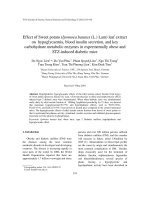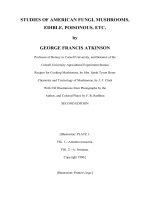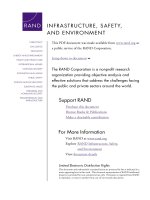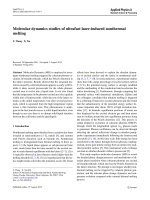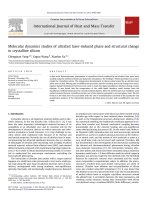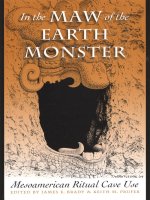Haematological studies of Loranthus Bengwensis Ethanolic leaf extract on streptozotocin induced diabetic rats
Bạn đang xem bản rút gọn của tài liệu. Xem và tải ngay bản đầy đủ của tài liệu tại đây (246.42 KB, 9 trang )
Int.J.Curr.Microbiol.App.Sci (2019) 8(3): 1780-1788
International Journal of Current Microbiology and Applied Sciences
ISSN: 2319-7706 Volume 8 Number 03 (2019)
Journal homepage:
Original Research Article
/>
Haematological Studies of Loranthus bengwensis Ethanolic Leaf Extract on
Streptozotocin Induced Diabetic Rats
R.U. Ukpanukpong1*, S.O. Oka2, O.E. Olarinde2, D.I. Basiru2,
B.E. Ukwuondi1 and P.O. Aigbadumah3
1
Department of Biochemistry, Faculty of Basic Medical Sciences
University of Calabar, Nigeria
2
Department of Chemical Sciences, Joseph Ayo Babalola University,
Ikeji Arakeji. Osun State, Nigeria
3
Faculty of Medical Sciences, University of Jos, Nigeria
*Corresponding author
ABSTRACT
Keywords
Phytochemicals,
Body Weight,
Haemoglobin,
Packed Cell
Volume, Platelets,
White Blood Cell
and Red Blood Cell
Article Info
Accepted:
15 February 2019
Available Online:
10 March 2019
The haematological studies on ethanolic leaf extract of Loranthus Bengwensis were
evaluated in streptozotocin induced diabetics albino rats. The phytochemical screening of
the ethanolic leaf extract showed the presence of alkaloids, flavonoids, steroids, tannin,
saponins, cardiac glycosides, phenolics, terpenoid and quinines. Sixty albino wistar rats
were used for the study and at the commencement of the experiment, rats were grouped
into six study groups; Non-diabetic Control group, Diabetic Control group, Diabetic rats
administered Orthodox drug insulin, Diabetic rats administered 100mg of leaf extract,
Diabetic group administered with 200mg of leaf extract; Diabetic group administered with
400mg of leaf extract. There was a drastic reduction in blood glucose level of diabetes
treated groups of DLB1, DBL2 and DBL3 at the end of the experiment which portrays the
therapeutic efficacy of Loranthus bengwensis ethanolic leaf extract in ameliorating
diabetic condition. However, the extract was more efficient at 400mg/kg compared to
100mg/kg and 200mg//kg respectively. This indicates that ethanolic leaf extract of
Loranthus bengwensis is relatively more efficient at higher concentration. Other
biochemical parameters such as; Haematological; Haemoglobin, Packed Cell Volume,
WBC, Platelets Count and Neutrophiles as well as body weight indices were consideration.
The results obtained from all these assays as well as the blood glucose assay justify the
therapeutic efficacy of Loranthus bengwensis on diabetic condition.
Introduction
Plants are important source of biologically
active substances; therefore they have been
used for medicinal purposes, since ancient
times. Plant materials are used as home
remedies, in over-the-counter drug products,
dietary supplements and as raw material for
phytochemicals. The use of medicinal plants is
usually based on traditional knowledge, from
1780
Int.J.Curr.Microbiol.App.Sci (2019) 8(3): 1780-1788
which their therapeutic properties are often
ratified
in
pharmacological
studies.
Nowadays, a considerable amount of
prescribed drug is still originated from
botanical sources and they are associated with
several pharmacological activities, such as
morphine for analgesic, scopolamine and
atropine as anticholinergics, galantamine
associated with Alzheimer's disease, quinine
as antimalarial, paclitaxel, vincristine and
vinblastine all used as anticancer drugs, as
well as digitalis glycosides used to alleviate
heart failure. The versatility of biological
actions can be attributed to the huge amount
and wide variety of secondary metabolites in
plant, belonging to several chemical classes as
alkaloids, coumarins, flavonoids, tannins,
terpenoids, xanthones, alkaloids, glycosides,
volatile oils, minerals and vitamins etc (Canter
et al., 2005).
However,
world
health
organization
consultative group define medicinal plants as
any plant in which one or more of its
constituents contain substances that can be
used for therapeutic purposes and may serve
as precursors for the synthesis of useful
metabolites. The general belief about
medicinal plant is that once a particular plant
is used in the olden days and it worked for a
particular ailment, people ignorantly start
using it not minding the adverse effects. But,
the advancement in medical science has really
done a great work in that few medicinal plants
pharmacokinetics is now known and some are
synthetically processed as supplements
(Sofowara, 1982). The high patronage for
herbal drugs, in spite of the efficiency of
synthetic drugs, is due to the misconception
that natural products are not toxic, fewer side
effects, with associated lower cost encourage
this alternative therapy. In developing
countries, herbal medicine is the main form of
health care. Surprisingly, most herbal
medicines do not have a defined dosage,
inadequate information on the chemical
composition and possible risks. Additionally,
poor quality control measures on herbal drugs,
may lead to adulteration and intrinsic factors
related to used raw material, do produce
variables and inconsistent effects.
Herbs are staging a comeback and herbal
„renaissance‟ is happening all over the globe.
The herbal products today symbolize safety in
contrast to the synthetics that are regarded as
unsafe to human and environment. Although
herbs had been priced for their medicinal,
flavoring and aromatic qualities for centuries,
the synthetic products of the modern age
surpassed their importance, for a while.
However, the blind dependence on synthetics
is over and people are returning to the naturals
with hope of safety and security. Over threequarters of the world population still relies
mainly on plants and plant extracts for health
care. More than 30% of the entire plant
species, at one time or other is used for
medicinal purposes (Odebiyi and Sofowora,
1978).
In spite of the overwhelming influences and
our dependence on modern medicine and
tremendous advances in synthetic drugs, a
large segment of the world population still
likes drugs from plants. In many of the
developing countries the use of plant drugs is
increasing because modern life saving drugs
are beyond the reach of three quarters of the
third world‟s population although many such
countries spend 40-50% of their total wealth
on drugs and health care. As a part of the
strategy to reduce the financial burden on
developing countries, it is obvious that herbal
medicine will be highly encouraged in the
future.
Materials and Methods
Chemicals
Streptozotocin, chloroform, ethanol and other
chemicals were obtained from Fam-lab
Nigeria Limited and Lixok-k chemicals,
1781
Int.J.Curr.Microbiol.App.Sci (2019) 8(3): 1780-1788
Akure. Alanine transaminases (ALT),
Aspartate transaminase (AST), Serum albumin
were obtained from Randox Laboratories
Limited, UK. Accu-check glucometer kit was
purchased from De-shalom pharmacy, Ilesa,
Osun State, Nigeria. All other chemicals used
were of analytical grade. De-ionised and
distilled water was also used during the
experimental process.
Preparation of plant extracts
Loranthus bengwensis leaves were sorted out
washed to remove dirts and dust particles and
air dried under shade for 4 weeks. The dried
materials were homogenized using mechanical
grinder and weighed in a weighing balance.
The powder form was kept in airtight
container and stored at 4oC until when needed
for further analysis.
Source of standard drug
Extraction procedures
Insulin injection (40Iµ/ml) marketed by May
and Baker, was obtained from a registered
pharmacist in De-shalom pharmacy, Ilesa,
Osun State, Nigeria and used for the study.
Experimental animals
Adult sixty (60) female albino rats weighing
between 90-250g were purchased from a
disease free stock of the University of Ibadan,
Nigeria and used for the study. The rats were
randomly assigned on the basis of their weight
into six study groups of eight (8) rats each.
Normal feeds and tap water were given to the
rats ad-libitum while food and water intake
were noted. They were kept in plastic cages of
8 rats per cage, placed in a well ventilated
animal house of Joseph Ayo Babalola
University at normal temperature of 30-35oC.
The cages were cleaned daily and rats were
treated according to the international
guidelines for the care and use of laboratory
animals (NIH, 2008). The animals were
allowed for two weeks of acclimatization and
their weights were measured before treatment
commenced.
150g of the powdered extract was soaked in
98% of ethanol in 250ml at room temperature
for 72 hours after which the mixture was
filtered. The filtrate was placed in centrifuge
at 540rev/min for 30 minutes. The centrifuged
sample formed 2 layers; the upper layer was
then poured inside another beaker. It was
boiled at 60oC using a water bath. During the
boiling process, it was observed that the
sample formed a crystal structure in a foaming
form. The resulting filtrate was air-dried at
room temperature into petri dishes. The
residue obtained was weighed and kept in airtight container at 4oC. Percentage yield was
determined from the weight of the dried
sample.
Phytochemical screening
Basic phytochemical screening was the
method employed to test the presence of
certain biologically active compounds in
plants e.g. tannins, saponins, antraquinone,
flavonoids, cardiac glycosides, steroids,
phenolics, cardenolides and denolides.
Plant materials and identification
Induction of diabetes
Fresh leaves of Loranthus bengwensis were
obtained from kolanut tree in Ikeji-Arakeji
plantation, Osun State, Nigeria. The plant
samples were taken to the Department of
Botany, Obafemi Awolowo University
(O.A.U) for identification and authentication.
Diabetes mellitus was induced by single
intraperitoneal dose of 60mg/kg of
streptozotocin (Sigma chemicals, St Louis
USA) dissolved in 0.1M fresh cold citrate
buffer at a pH of 4.5 into 12 hours overnight
fasted rats (Burcelin et al., 1995). After 3
1782
Int.J.Curr.Microbiol.App.Sci (2019) 8(3): 1780-1788
days, fasting blood sugar levels were
monitored with a glucometer (Accu check
active, Roche Diagnostics GmbH, Germany)
and the rats having fasting blood glucose
levels more than 200mg/dl were isolated,
classified
diabetic
and
used
for
experimentation.
Total white blood cell count: This was
determined using bulk dilution method of
Ochei and Kolhatkar (2007).
Experimental design
The grouping and treatment given to the rats
in each groups are as follows; Group A:
Designated as NDC consisted of non-diabetic
control rats administered 1ml of distilled
water. Group B: Designated as DC consisted
of diabetic control rats administered 1ml of
streptozotocin. Group C: Designated as DO
consisted of diabetic rats administered 1ml of
orthodox drug (insulin). Group D: Designated
as DLB1 consisted of diabetic rats
administered
100mg/kg
of
Loranthus
bengwensis ethanolic leaf extract. Group E:
Designated as DLB2 consisted of diabetic rats
administered
200mg/kg
of
Loranthus
bengwensis ethanolic leaf extract. Group F:
Designated as DLB3 consisted of diabetic rats
administered
400mg/kg
of
Loranthus
bengwensis ethanolic leaf extract.
Determination
parameters
Procedure: The capillary tube was filled with
the mixed blood up to ¾ of its length, one of
the ends of the capillary was sealed with
plasticine. It was placed in the centrifuge and
spun for 5mins at 12,000rpm. It was then read
on the hematocrit reader.
of
haematological
Packed cell volume
Method: Micro haematocrit (Baker and
Silverton, 2003)
Materials: Capillary tube, Haematocrit
centrifuge, Haematocrit reader, Plasticine.
Principle: Anticoagulant blood in a glass
capillary of specified length, bore size and
wall thickness is centrifuged at 12,000 rpm for
5 minutes to obtain a constant packing of the
red blood cells while the plasma remains
above the cells.
Differential white cell count
Haemoglobin estimation: Haemoglobin was
determined using the method of (Baker and
Silverton, 2003).
Mean
corpuscular
concentration
hemoglobin
Principle: The mean corpuscular hemoglobin
concentration is a measure of the
concentration of hemoglobin in a given
volume of packed cell blood cells. It is
reported as part of standard complete blood
count.
Method: It was calculated by dividing the
hemoglobin by the hematocrit. Reference
ranges for blood tests are 32 to 36 g/dl, or
between 19.9 and 22.3 mmol/l.
Sacrifice of the animals and serum
collection: At the end of the experimental
period, rats in each study group were fasted
overnight and sacrificed under anesthesia by
cervical dislocation. After the rats have been
sacrificed, 2-4ml of blood was collected from
each rat and placed in specific sterile bottles
(plain bottles for enzyme analysis and EDTA
bottles for haematological indices). For
enzyme analysis, the blood was allowed to
stand for 30 minutes to clot and then
centrifuge at 4000g for 15 minutes. The
supernatant, which is the serum, was carefully
decanted and was kept at 4oC for further
analysis.
1783
Int.J.Curr.Microbiol.App.Sci (2019) 8(3): 1780-1788
Statistical analysis: The data will be
expressed as Mean value ± S.E.M (Standard
error of the mean). All results will be mean of
8 data samples and the statistical analysis will
be carried out using student‟s t-test. The
values will be considered at probability level
of P<0.05.
and methanolic root bark extract of Acacia
albida (Salisu et al., 2009). These findings are
in agreement with Olatunde and Dikwa (2014)
who carried out an experiment on the
qualitative and quantitative analysis of
phytochemicals in Loranthus bengwensis leaf
and had similar findings.
Results and Discussion
The body weight indices of the experimental
groups, at the commencement of the
experiment compared to its weight at the end
of the experiment demonstrated a significant
increase (Fig. 1). This can be attributed to the
administration of ethanolic extract of
Loranthus bengwensis which can hence be
said to cause an increase in body weight. This
increase was however more significant (p <
0.05) in the ethanolic extract treated groups
(Group D, E and F) than in the standard drug
treated group (Group C). This is in contrast
with a research carried out by Mojekwu et al.,
(2011) who used Aframomum melegueta to
ameliorate the diabetic condition in the
experimental rats and discovered a decrease in
body weight at varying concentrations of the
aqueous leaf extract of Aframomum
melegueta.
Herbal medicine have recently drawn much
attention as an alternative medicine useful for
treatment and prevention of lifestyle related
disorders but there is inadequate knowledge
on the pharmacokinetics of medicinal plants.
There is a growing interest in the analysis of
plant products which has stimulated intense
research on their potential health benefits
(Viswanath et al., 2007). There are about 200
pure compounds from plant sources reported
to show hypoglycemic effect. The compounds
include alkaloids, carbohydrates, amino acids,
lipids, flavonoids, steroids, terpenoids,
glycosides, glycopeptides, phenolics as well as
many other phytochemical constituents (Table
1). More than 1200 species of plant have been
screened for activity on the basis of ethanomedicinal uses (Dewanjee et al., 2009).
The phytochemical analysis of the ethanolic
leaf extract of Loranthus bengwensis contains
important phytoconstituents such as alkaloids,
flavonoids, steroids, tannins, saponins, cardiac
glycosides, phenolics, terpenoids and quinones
while anthraquinones, cardenolides and
denolides and oxalates and are absent.
Flavonoids and tannins have been reported to
cause regeneration of damaged pancreatic
islets, stimulate calcium and glucose uptake
(Tapas et al., 2008). These compounds are
also known to be responsible for the
hypoglycemic
activity
of
Loranthus
bengwensis as compared with other
hypoglycemic plants which contains similar
phytoconstituents as found in Luffa
acutangula fruit extract (Pimple et al., 2011)
The haematological results shows that
administration of ethanolic leaf extract of
Loranthus bengwensis had increasing effects
on all haematological parameters at all
concentrations of the extract (Fig. 2). This
shows that the extract has the ability to
increase blood volume and hence constituting
haematological components. Compared to the
positive control group, there was an
insignificant increase in the WBC count of the
rats in the extract treated groups (Group D, E
and F) at P<0.05. This shows the activity of
the WBC count in fighting the preceding
diabetic condition serving as the second line
of immunological defense. The white blood
cell count however began to decrease
significantly (at P<0.05) as the extract began
to ameliorate the diabetic condition as
1784
Int.J.Curr.Microbiol.App.Sci (2019) 8(3): 1780-1788
observed when compared to the negative
control group. Also, a decrease was observed
in orthodox treated group (Group C) when
compared to the negative control group. This
decrease
was
however
statistically
insignificant at P<0.05.
The Packed Cell Volume (PCV) is a fraction
of the whole blood volume that consists of red
blood cells. The PCV is on the increase in all
treated groups (Group C, D, E and F)
compared to the non-diabetic control group.
This increase is however statistically
insignificant at P<0.05. A significant increase
was observed in all treated groups when
compared to the negative control group.
Hemoglobin is one-third of the packed cell
volume and is responsible for oxygen
transport in the blood. There was a significant
increase in the groups treated with ethanolic
leaf extract of Loranthus bengwensis as
compared to the negative control group and
positive control group. Platelets are involved
in blood clotting and are a major component
of the blood. There was a significant increase
in platelet count in all ethanolic leaf extract
treated groups when compared to the negative
control due to the ability of the plant extract to
increase total blood volume and hence its
constituting components. But there was an
insignificant decrease in the platelets count of
all treated groups when compared to the nondiabetic control group (Fig. 3 and 4).
Table.1 Phytochemical screening of ethanolic leaf extract of Loranthus bengwensis
S/N
1
2
3
4
5
6
7
8
9
10
11
12
Phytochemicals
Inference
Alkaloids
+
Flavonoids
+
Cardiac glycosides
+
Steroids
+
Saponins
+
Tannins
+
Anthraquinones
Phenolics
+
Terpenoids
+
Quinones
+
Oxalates
Cardenolides and Denolides
+ indicates the presence of the phytochemical
- indicates the absence of the phytochemical.
Fig.1 Body weight indices of experimental rats.
Values expressed in Mean ± S.E.M of 8 determinations
1785
Int.J.Curr.Microbiol.App.Sci (2019) 8(3): 1780-1788
Fig.2 Haemoglobin, Pack cell volume and Neutrophils levels of experimental rats
Values expressed in Mean ± S.E.M of 8 determinations
Fig.3 White blood cell count of experimental rats
Values expressed in Mean ± S.E.M of 8 determinations
Fig.4 Platelets count of the experimental rats
Values expressed in Mean ± S.E.M of 8 determinations
1786
Int.J.Curr.Microbiol.App.Sci (2019) 8(3): 1780-1788
Neutrophils are the most abundant type of
white blood cells in the blood. They are
essential in destruction and removal of some
species of bacteria, wastes, foreign substances
with the sole purpose of protecting the body.
A decrease was observed in the neutrophils
count of groups treated with ethanolic leaf
extract of Loranthus bengwensis when
compared to the negative control (Group B)
because of the ability of the leaf extract to
ameliorate the diabetic condition and
therefore, initiate a reduction in the
production of white blood cells and hence,
neutrophils. This decrease was however
statistically insignificant at P<0.05. An
increase was however observed in these
treated groups when compared to the positive
control group due to the pre-diabetic
condition of the rats. A decrease compared to
the negative control group (Group B) was also
observed in the orthodox treated group
(Group C), this decrease was however less
significant compared to the groups treated
with ethanolic leaf extract of Loranthus
bengwensis.
Urea which is an important metabolite in the
urine and also a major nitrogen containing
compound in urine. It plays a role as a major
carrier of nitrogen. There was a statistically
non significant decrease (P< 0.05) in the urea
levels of the extract treated groups, D, E and
F compared to the negative control group.
This may be due to the ability of the plant
extract to reduce urea levels in the blood
serum of the rats, at varying concentrations,
maybe by facilitating their excretion through
the urine.
References
A.O.A.C. (2001). Official methods of
analysis, 16th edition. Association of
Official Analytical
Chemist,
Arlington, V.A. Pp 267
Baker, R and Silverton, T. (2003). Blood:
Principles & Practice of Hematology.
Lippincott
Williams & Wilkins
Jounr. 89(6):78-82
Canter, B.C., Robert, J., Philip, M., and
Guyton, F.K. (2005). Pharmacological
actions of Abies pindrow Royle leaf.
Indian Jour. Expt. Biol; 36:187-191.
Dewanjee, S., Das, A.K., Sahu, Ri and
Gangopadhyay, M. (2009). Antidiabetic
activity of
Diospyrous peregina
fruit:
effect
on
hyperglycemia,
hyperlipidemia
and
augumented
oxidative stress in experimental type 2
diabetes.
Food
Chem.
Toxicol.,
47:2679-2685.
Mojekwu T.O., Yama O. E., Ojokuku S.A.
and
Oyebadejo
S.A.
(2011).
Hypoglycemic Effects of
Aqueous
Extract of Aframomum melegueta Leaf
on Alloxan-Induced Diabetic Male
Albino Rats. Pac J. Med Sci: 8(1):356378
Ochei, R. and Kolhatkar, J. (2007).
“Invivonear-Infrared
spectroscopy”.
Annual
Review
of
Biomedical
Engineering 6(2): 715-754.
Odebiyi, A., and Sofowora, A.E. (1978).
Phytochemical screening of Nigeria
Medicinal Plants (Part III). Lioydia 41:
234 – 246.
Olatunde Ahmed and Dikwa Mohammad Ali
(2014). Qualitative and quantitative
analysis of phytochemicals in Loranthus
bengwensis leaf. Int RJ Pharm. Sci.
5(1):10-12.
Pimple P, Kadam V, Patil J (2011).
Antidiabetic and antihyperlipidemic
activity of Luffa actungula fruit extracts
in streptozotocin induced Niddm rats.
Asian J. Pharm. Clin. Res. 4(2):156163.
Proctor, P. (1970). Similar functions of uric
acid and ascorbate in man. Nature. 228
(5): 868.
Reitman FJ and Frankel ET (1957).
"Purification and characterization of
1787
Int.J.Curr.Microbiol.App.Sci (2019) 8(3): 1780-1788
aspartate aminotransferase from the
halophile archaebacterium Haloferax
mediterranei". Biochem Journ 278 (1):
149–154.
Salisu Y, Abubakar M, Ibrahim G (2009).
Hypoglycemic effects of Acacia albida
methanolic root bark extract. Niger. J.
Pharm. Sci. 8(1):66-72.
Sofowara A, (1982). Medicinal Plants and
Traditional medicine in Africa. Asian
Pac. J. Trop. Med. 21(6): 427-433.
Tapas A, Sakarkar D, Kakde R (2008).
Flavonoids as Nutraceuticals: A review.
Trop. J. Pharm. Res. 7:1089-1099.
Viswanath G.L., Srinath R, Nandakumar K,
Shylaja H and Lakshman K. (2007).
Antidiarrheal activity of alcoholic and
aqueous extracts of stem bark of
Thespesia
populnea
in
rodents.
Pharmacologyonline; 3(1) 222-230.
Wright A and Plummer C (1974). "A finestructure genetic and chemical study of
the enzyme alkaline phosphatase of E.
coli. I. Purification and characterization
of alkaline phosphatase". Biochim.
Biophys. Acta 38(4): 470–483.
How to cite this article:
Ukpanukpong, R.U., S.O. Oka, O.E. Olarinde, D.I. Basiru, B.E. Ukwuondi and Aigbadumah,
P.O. 2019. Haematological Studies of Loranthus bengwensis Ethanolic Leaf Extract on
Streptozotocin Induced Diabetic Rats. Int.J.Curr.Microbiol.App.Sci. 8(03): 1780-1788.
doi: />
1788
